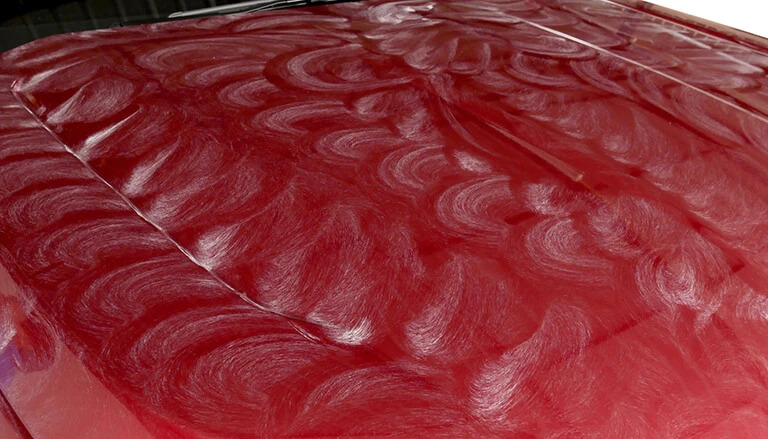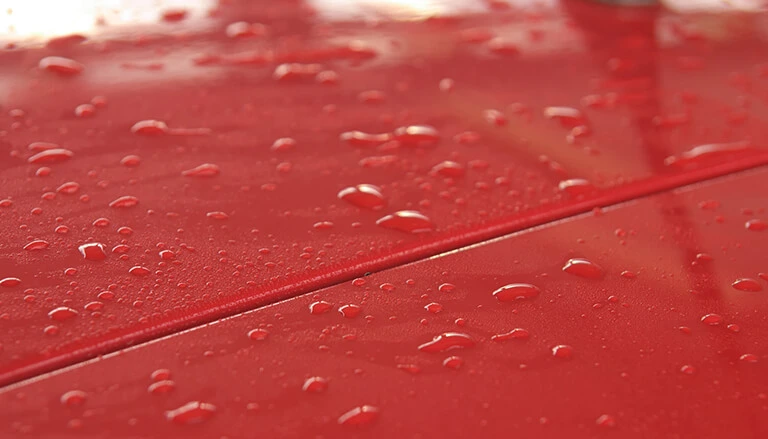Applying wax to your car is a great way to keep it looking its best. Wax helps to protect the paint and provides a deep and long-lasting shine to your paintwork, while also making your car easier to clean in the future.
In this guide, we’ll answer all your burning questions about wax – what it is, the different types of wax and how to apply it like a true car enthusiast. We’ll also cover the surprising benefits of waxing your car on a regular basis.
Personally, I’m a huge fan of waxing my car on a regular basis. It feels like the cherry on top of my weekly washing process. The good news is that it doesn’t have to be difficult, or expensive, to wax your car.
Let’s dive into the basics of vehicle wax products and why you should be adding it to your car cleaning routine.

What is car wax?
Vehicle waxes are used to protect and enhance the appearance of cars. They are sold in liquid or paste form with properties that protect the paintwork from environmental factors like UV rays, water, bird droppings and other debris.
Wax products have come a long way since the establishment of the famous Turtle Wax brand in 1941. Manufacturers have been working hard to make waxes more affordable and easier to apply for the everyday car cleaner.
Waxes come in a liquid or paste form and are designed to be applied directly to your vehicle’s paintwork.
Once applied, the wax needs to be ‘buffed’ in with a cloth or application pad. Buffing is just a repeated rubbing motion that eliminates excess wax and allows the wax to bond with your paintwork.
Once buffed, wax helps to protect your vehicle’s paint from outside contaminants. Wax is also hydrophobic, which helps to repel water. You may have seen this demonstrated as beading water on waxed cars.
Lots of popular car soaps now include small amounts of wax (usually called a ‘wash and wax’) to increase protection during those weekly washes.

The different types of wax
There are several different types of car waxes available on the market today. While they all provide similar benefits, there are other factors to consider, like the ease of application and how long they last. Here’s the lowdown:
Liquid waxes
Liquid waxes are exactly that: liquid. They are sold in a thick liquid form which is easy to apply and buff. Liquid waxes are designed to be applied with a small microfibre cloth or foam applicator pad. Good quality liquid waxes will leave behind a satisfying shine and great protection to last.
Paste waxes
Paste waxes are a thicker alternative to liquid waxes, and they are mostly synthetic. Much like liquid waxes, they are also applied with a microfibre cloth or a foam application pad. However, they can be more difficult to apply correctly. Carnauba is a popular ingredient in paste waxes due to its natural ability to repel water. Paste waxes are very popular amongst detailers for their durability and hydrophobic properties.
Spray waxes
Spray waxes are my favorite type of wax to use. They’re super easy to apply and they’re very inexpensive. Spray waxes are applied directly to the paintwork with a spray bottle. To buff the wax, you can simply spread the wax over the panel with a microfibre towel. Some spray waxes can even be applied straight to a wet car! The only real downside is the longevity – most spray waxes won’t last for more than a month or two.
Synthetic waxes
Synthetic waxes are waxes that contain artificial polymers which boost the benefits of natural wax. Synthetic waxes are available in liquid, paste and spray forms. The main benefit of using synthetic wax is its durability – some synthetic waxes can last on a car for 6 months and beyond. The only thing that a synthetic wax can not replicate as well as a natural wax is the deep shine associated with carnauba waxes.
Natural waxes
Natural waxes use organic ingredients – like carnauba, a wax derived from the Copernicia Cerifera plant in Brazil. Carnauba is naturally water repellent and buffs to a deep, beautiful shine on your vehicle. For wax to be considered natural, it must contain carnauba. As a result, natural waxes can be a bit more expensive than synthetic waxes – but you won’t be disappointed with the results.
Now that you’re clued up on the different types of waxes on the market, let’s take a deep dive into the benefits of applying wax to your pride and joy.

Four benefits of waxing your car
1: It enhances your car’s appearance
Simply put, wax helps to bring your paintwork back to life. If your car’s paint has dull spots or light scratches, applying wax will increase its vibrancy and help to buff out blemishes in the clear coat.
For even better results, you can use a clay bar before applying wax to your vehicle. Using clay helps to remove contaminants that are bedded into your paint, and it helps to give a strong foundational layer for the wax.
Wax is the perfect finishing touch for any afternoon car cleaning session. Wash your car, apply wax, take a step back and appreciate a job well done!
2: It protects your car’s paint
As well as making your car look great, wax helps to form a protective barrier for your vehicle’s paintwork. This barrier helps to protect the clear coat from contaminants and blemishes, like bird droppings and tree sap.
Contaminants can really harm your paintwork if left long enough on unprotected paint. Yes, even bird poop, which can be highly acidic and a real danger to the integrity of your clear coat. That’s why it’s a good idea to protect your car’s appearance for the long run and invest in some wax!
3: It makes your car easier to clean
Did you know that a waxed car is easier to clean? Because of the protective barrier formed by car wax, you won’t have to deal with embedded dirt and contaminants in future washes. This will save you a lot of time and effort!
Most waxes will withstand multiple washes before losing any of its effectiveness – so don’t worry about applying wax on every wash. It’s always best to check the instructions on the wax product you’re using to see how long it will last.

4: it’s hydrophobic
And last but not least, the best feature of any wax – it’s hydrophobic. There’s nothing more satisfying for a car enthusiast than seeing beading water on their ride after a good detail.
When the wax is applied to your vehicle, rain and water will slide over the panels with ease. Sure, there’s no real benefit to this – but it looks awesome!
How to apply wax to your car
Here’s our step-by-step guide on applying wax to your vehicle:
- Thoroughly wash and clean your car
- Apply the wax product directly to the vehicle (or on an applicator pad)
- Work the wax into one panel at a time with light and even circular motions
- Buff the wax to a light haze
- Once the wax dries to a light haze, remove the excess with a microfiber cloth
- Turn the cloth regularly, and dry the panel to a deep shine
As always with detailing your car, preparation is key. Make sure that you’re working with a clean car before applying any type of wax product.
Most popular waxes are simple and easy to use, but some specialist products may require slightly different applications. In any case, check the instructions on the bottle or tube to ensure you’re applying the wax correctly and getting the most out of it.
How often should I wax my car?
Generally, it’s a good idea to re-apply wax to your car every four months. This will keep your paintwork protected and looking good. Of course, this depends on your chosen wax, how often you use the car and how regularly you wash it.
There is no such thing as waxing your car too much – but you won’t want to waste your hard-earned cash by applying wax too often. This is why it’s a good idea to re-apply wax every three to four months.
It’s also important to note that only one layer of wax will adhere to your paint at a time, so don’t worry about applying multiple layers of wax to one panel. Make sure that you check the guidance on your chosen product for tips on how often to apply the wax.
Believe it or not, a few years back, I used to wax my car every WEEK. That turned out rather expensive. Some car enthusiasts like to apply wax once before summer and once before winter to keep their vehicle looking sweet all year round. Ultimately, though, it’s up to you how often you use it!
FAQs
Do newer cars still need waxing?
Yes, new cars still require waxing to keep the paint contaminant-free and glossy all year round.
In the olden days, car dealerships would recommend leaving your car wax-free for a while to allow the paint and undercoat to cure. Nowadays, it’s absolutely fine to wax your new car as soon as you would like to.
Some owners like to protect their brand new vehicles with wax from the get-go to safeguard the value of their car. For others, it’s a right of passage to wash and wax a new vehicle as soon as they get it home.
Is waxing a car worth it?
Yes, waxing your car is 100% worthwhile. With time and practice, you will become super efficient at applying wax to your vehicle – and the results will always be satisfying. You can feel confident in the fact that you’re protecting your paint and making your car look awesome at the same time.
Can wax remove scratches?
Some waxes are designed to hide light scratches and scuffs from your paintwork, but they do not remove them. Vehicle waxes hide scratches by ‘filling’ them in and disguising them with a shiny new layer. Keep in mind that this isn’t a permanent fix, and the scratches will return once the wax has worn off.
Which is better: polish or wax?
Car wax and car polish are two very different products. While wax is designed to protect your car’s paint and clearcoat, polish is designed to remove scratches and scuffs from the paint. If your paint is looking particularly dull this year, consider giving your car a good polish and waxing it to seal the deal.
Conclusion
Hopefully, this guide helped you to feel confident and prepared in applying wax to your vehicle. Likewise, I hope it helped to clear up any myths and rumours surrounding wax in the car community.
You don’t have to be an A-star detailer to apply wax to your car. I’m not, and I’ve been reaping the rewards ever since I picked up a bottle of spray wax at my local store. Now rain, bird poop and seasonal debris never even touch my paintwork.
Have you got any handy tips for applying wax to your vehicle? Let us know below! It’s for the good of the community.